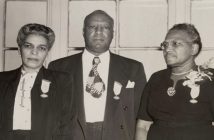As we celebrate Women’s History Month, we must remember the important roles women have played throughout the history of the labor movement.
Many of you may have heard about 19th and early 20th century labor organizer Mary Harris “Mother” Jones, who famously said, “Pray for the dead and fight like hell for the living!” More recent examples of women labor leaders include Hattie Canty, who led hospitality workers in the longest strike in U.S. labor history; Delores Huerta, who helped lead the iconic grape strike that highlighted the plight of farmworkers and Liz Shuler, who is making her mark as the AFL-CIO’s first woman president.
These are just a few famous examples of the work of leading women in labor unions, but women have been organizing unions and leading the fight for fair pay, health care, workplace safety and health and social justice since the early 19th century. In many cases, these early labor groups were separated by gender and race. While many of their stories may be less well known, they are incredibly important to the success of the labor movement in our country.
In 1825, the first union for women, the United Tailoresses of New York, was formed to fight against unfair wages and poor working conditions, which resulted in increased public awareness of the plight of textile and clothing industry workers. In the 1840s, women employed at the textile mills in Lowell, Massachusetts were one of the first groups of working women in U.S. history to organize, go on strike and engage in political action to improve their working conditions and their lives.
While the Lowell workers saw a limited victory, it showed that working women could make real, positive changes when they stood together and fought for justice. Today, nearly 200 years after the first unions were formed, we have seen numerous instances in which women used their voices to gain power and get justice, including advancing the ongoing fights to end discrimination, secure voting rights, get safer working conditions and move us closer to pay equity.
Union women have also been key to women winning the right to vote. The women’s suffrage movement began in Seneca Falls at the 1848 Women’s Rights Convention. Women rights activists Susan B. Anthony and Elizabeth Cady Stanton worked together to fight for a U.S. Constitutional amendment to grant suffrage to all. Anthony was notably arrested and later convicted for voting in the 1872 Presidential election.
As the suffrage movement intensified in the early 20th century, suffragist leaders recruited labor union women into their ongoing fight to win the right to vote and adopted union activism tactics that include demonstrations and political action. Many suffragists faced violence, torture and imprisonment for their cause, including Alice Paul and Lucy Burns. Women constitutionally won the right to vote in 1920, but Black, Latina and Asian women were among those who could not exercise this right until 1965.
Throughout history, unions have been the great equalizer. A union membership is a working person’s ticket out of poverty and into the middle class. Union women make on average 23 percent more than nonunion women, and they are far more likely to have fair earnings, health benefits, workplace safety standards and a secure retirement, largely because of the actions of labor union women.
By no means is our struggle for justice over. There are still many fights to win. Working women still make 83 cents to every dollar men make, and the pay gap is even greater for Black and Latina women. We also find ourselves in a fight for our health care rights.
This is why it’s so important for union women to discuss our history, make history and pass the knowledge we have to the next generation of union members. It is also important to use our voices. I am proud to be working with our union’s Standing Women’s Committee on our next Women’s Conference, which will be held in April in Saratoga Springs. The theme is “Our Voice Our Power,” and I urge union members to ask your leaders what they have learned so that we all can all use our voices to increase our power, improving not just the lives of working women, but everyone’s lives.

